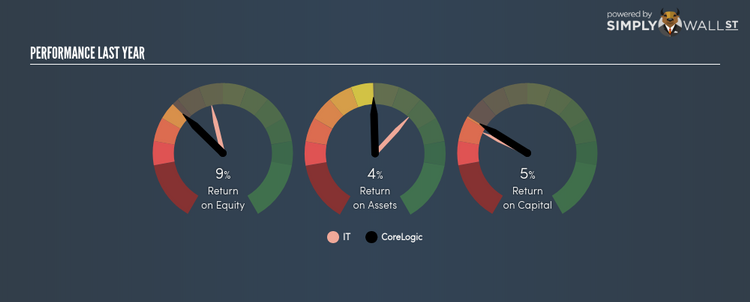How Did CoreLogic Inc’s (NYSE:CLGX) 8.69% ROE Fare Against The Industry?

CoreLogic Inc (NYSE:CLGX) delivered a less impressive 8.69% ROE over the past year, compared to the 13.86% return generated by its industry. An investor may attribute an inferior ROE to a relatively inefficient performance, and whilst this can often be the case, knowing the nuts and bolts of the ROE calculation may change that perspective and give you a deeper insight into CLGX’s past performance. Today I will look at how components such as financial leverage can influence ROE which may impact the sustainability of CLGX’s returns. Check out our latest analysis for CoreLogic
What you must know about ROE
Firstly, Return on Equity, or ROE, is simply the percentage of last years’ earning against the book value of shareholders’ equity. It essentially shows how much the company can generate in earnings given the amount of equity it has raised. While a higher ROE is preferred in most cases, there are several other factors we should consider before drawing any conclusions.
Return on Equity = Net Profit ÷ Shareholders Equity
ROE is assessed against cost of equity, which is measured using the Capital Asset Pricing Model (CAPM) – but let’s not dive into the details of that today. For now, let’s just look at the cost of equity number for CoreLogic, which is 10.97%. Given a discrepancy of -2.28% between return and cost, this indicated that CoreLogic may be paying more for its capital than what it’s generating in return. ROE can be dissected into three distinct ratios: net profit margin, asset turnover, and financial leverage. This is called the Dupont Formula:
Dupont Formula
ROE = profit margin × asset turnover × financial leverage
ROE = (annual net profit ÷ sales) × (sales ÷ assets) × (assets ÷ shareholders’ equity)
ROE = annual net profit ÷ shareholders’ equity

The first component is profit margin, which measures how much of sales is retained after the company pays for all its expenses. Asset turnover shows how much revenue CoreLogic can generate with its current asset base. And finally, financial leverage is simply how much of assets are funded by equity, which exhibits how sustainable the company’s capital structure is. Since financial leverage can artificially inflate ROE, we need to look at how much debt CoreLogic currently has. At 178.65%, CoreLogic’s debt-to-equity ratio appears relatively high and indicates the below-average ROE is already being generated by significant leverage levels.

What this means for you:
Are you a shareholder? CLGX’s below-industry ROE is disappointing, furthermore, its returns were not even high enough to cover its own cost of equity. Additionally, its high debt level appears to be a key driver of its ROE and is something you should be mindful of before adding more of CLGX to your portfolio. If you’re looking for new ideas for high-returning stocks, you should take a look at our free platform to see the list of stocks with Return on Equity over 20%.
Are you a potential investor? If you are considering investing in CLGX, basing your decision on ROE alone is certainly not sufficient. I recommend you do additional fundamental analysis by looking through our most recent infographic report on CoreLogic to help you make a more informed investment decision.
To help readers see pass the short term volatility of the financial market, we aim to bring you a long-term focused research analysis purely driven by fundamental data. Note that our analysis does not factor in the latest price sensitive company announcements.
The author is an independent contributor and at the time of publication had no position in the stocks mentioned.
